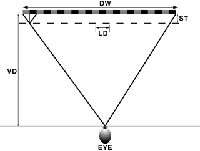The Varrier Auto-Stereographic Display
January 20th, 2001
Categories: Devices, Human Factors, Software, Tele-Immersion

Authors
Sandin, D., Margolis, T., Dawe, G., Leigh, J., DeFanti, T.About
The goal of our Varrier research is to develop a head-tracked, stereo virtual reality system utilizing plasma or LCD panels. This paper describes a head-tracked barrier auto-stereographic method that is optimized for real-time interactive virtual reality systems. In this method, a virtual barrier screen is created simulating the physical barrier screen, and placed in the virtual world in front of the projection plane. An off-axis perspective projection of this barrier screen, combined with the rest of the virtual world, is projected from at least two viewpoints corresponding to the eye positions of the head-tracked viewer. During the rendering process, the simulated barrier screen effectively casts shadows on the projection plane. Since the different projection points cast shadows at different angles, the different viewpoints are spatially separated on the projection plane. These spatially separated images are projected into the viewer’s space at different angles by the physical barrier screen.
The flexibility of this computational process allows more complicated barrier screens than the parallel opaque lines typically used in barrier strip auto-stereography. In addition, this method supports the focusing and steering of images for a user’s given viewpoint, and allows for very wide angles of view. This method can produce an effective panel-based auto-stereo virtual reality system.
Resources
URL
Citation
Sandin, D., Margolis, T., Dawe, G., Leigh, J., DeFanti, T., The Varrier Auto-Stereographic Display, SPIE, vol 4297, no 25, San Jose, California, January 20th, 2001. http://www.evl.uic.edu/todd/varrier/VarrierSPIE.html